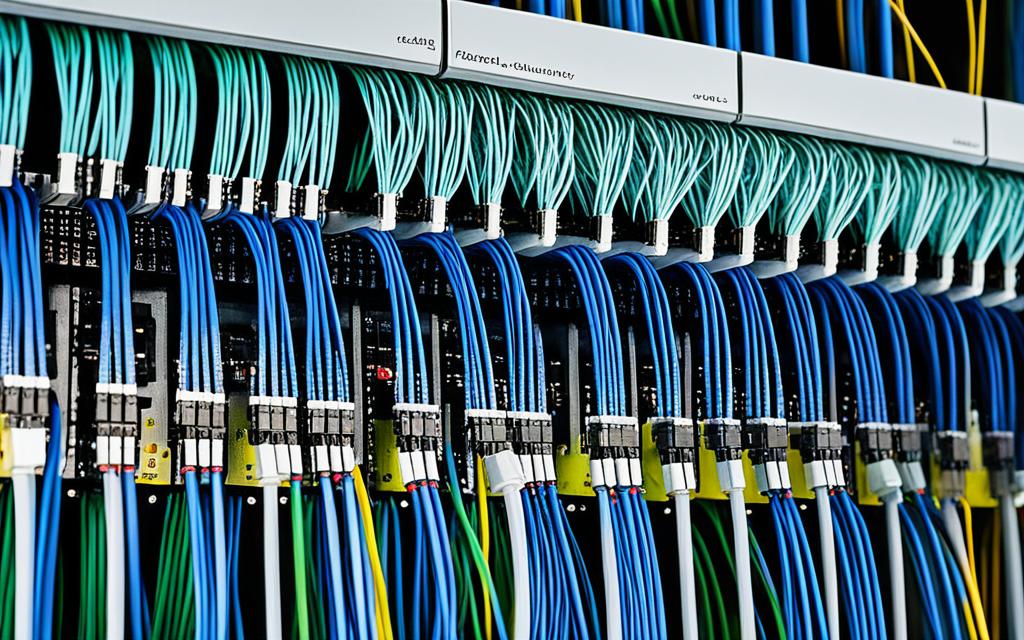Network redundancy is a critical strategy that enhances the reliability and uptime of fiber optic networks. It involves duplicating network paths and components to ensure seamless connectivity even if one part fails.
The benefits of network redundancy include enhanced reliability, improved uptime, load balancing for better performance, disaster recovery capabilities, and scalability for business growth.
Companies like 123NET offer network redundancy services that include diverse fiber routes, data center redundancy, power redundancy, network monitoring, and high-quality support.
Network redundancy is crucial in maintaining uninterrupted connectivity and ensuring business continuity. By implementing a redundant network infrastructure, companies can achieve enhanced reliability, improved uptime, and seamless connectivity.
With the increasing reliance on fiber optic networks, the need for network redundancy becomes even more important. It not only provides a backup system in case of failures but also allows for load balancing and scalability as businesses grow.
123NET is a trusted provider of network redundancy services, offering diverse fiber routes, data center redundancy, power redundancy, network monitoring, and high-quality support. Their comprehensive solutions ensure maximum uptime and resilience for businesses in today’s digital landscape.
Investing in network redundancy is a proactive step towards maintaining a reliable network, improving uptime, and safeguarding against potential disruptions. With the support of experts like 123NET, businesses can confidently navigate the digital realm and ensure seamless connectivity for their operations.
What is Network Redundancy and Why is it Important?
In today’s highly connected world, businesses rely heavily on seamless connectivity to ensure uninterrupted operations and deliver exceptional service. However, network failures and disruptions can occur, leading to costly downtime and service interruptions. This is where network redundancy comes into play.
Network redundancy refers to the practice of duplicating network paths and components to create a backup system that automatically kicks in when a failure or disruption is detected. By having redundant network infrastructure in place, businesses can mitigate the impact of service interruptions and maintain continuous connectivity.
So why is network redundancy important? Let’s explore its significance:
- Enhanced Network Reliability: Network redundancy enhances the reliability of the network by ensuring that even if one part of the network fails, there is an alternative route or component ready to take over seamlessly. This minimizes the risk of downtime and improves overall network performance.
- Minimized Service Interruptions: By implementing network redundancy, businesses can minimize service interruptions. The redundant system acts as a fail-safe mechanism that automatically switches to an alternative path or component when an issue occurs, ensuring uninterrupted connectivity.
- Seamless Connectivity: Network redundancy is especially crucial for businesses that operate around the clock and can’t afford any interruptions. With redundant network paths and components, seamless connectivity is maintained, allowing organizations to deliver consistent services to their customers.
- Improved Network Performance: Network redundancy enables load balancing, distributing network traffic evenly across multiple paths or components. This not only improves network performance but also reduces the risk of overload, ensuring smooth operations.
Network redundancy plays a vital role in maintaining seamless connectivity, especially in the context of fiber optic networks. With the increasing dependence on fiber optics for high-speed data transmission, having redundant paths and components becomes even more crucial.
To visualize the importance of network redundancy in fiber optic networks, consider the following scenario:
| Without Network Redundancy | With Network Redundancy | |
|---|---|---|
| Service Interruptions | High risk of service interruptions due to single-point failures. | Minimal service interruptions due to seamless failover to redundant paths or components. |
| Reliability | Potential downtime and unreliable network performance. | Enhanced reliability and improved uptime, reducing the risk of downtime. |
| Customer Satisfaction | Inconsistent service delivery leading to customer dissatisfaction. | Consistent and reliable service provision, building trust and satisfaction. |
As demonstrated in the table above, network redundancy in fiber optic networks offers significant advantages, including enhanced reliability, improved uptime, seamless failover, and improved customer satisfaction.
To summarize, network redundancy is essential for maintaining reliable and seamless connectivity in the face of failures and disruptions. It ensures uninterrupted operations, improves network performance, and minimizes the risk of downtime and service interruptions. In the context of fiber optic networks, network redundancy plays a vital role in safeguarding consistent and high-speed data transmission. By investing in network redundancy, businesses can prioritize their continuity and deliver exceptional services to their customers.
Benefits of Network Redundancy in Fiber Optic Networks
Network redundancy in fiber optic networks offers several benefits. Firstly, it enhances reliability by ensuring that if one path or component fails, the redundant system takes over immediately, reducing the risk of downtime. Secondly, it improves uptime, allowing customers to access services or products consistently, building trust and satisfaction. Thirdly, network redundancy enables load balancing, distributing network traffic evenly across multiple paths or components, which improves network performance and reduces overload risks. Fourthly, network redundancy provides disaster recovery capabilities, ensuring that data and services remain accessible even in the face of natural calamities or cyberattacks. Lastly, network redundancy allows businesses to scale their operations more easily without compromising network reliability or uptime.
“Network redundancy acts as a safety net for businesses, providing a robust and resilient infrastructure that can withstand unexpected disruptions. By incorporating redundancy into their fiber optic networks, organizations can achieve enhanced reliability, improved uptime, and seamless connectivity.”
The Role of Load Balancing
One of the key benefits of network redundancy is the ability to achieve load balancing. With load balancing, network traffic is distributed across multiple paths or components, preventing overload on any single element. This not only improves network performance and responsiveness but also ensures that no single point of failure can bring down the entire network. Load balancing allows businesses to handle increasing traffic demands efficiently and maintain optimal performance levels.
Disaster Recovery and Business Continuity
In an increasingly interconnected world, where businesses heavily rely on digital infrastructure, maintaining uninterrupted operations is crucial. Network redundancy plays a vital role in disaster recovery and business continuity planning. By ensuring redundant pathways and components, businesses can protect their critical data and services even in the face of natural disasters, system failures, or cyberattacks. This enables swift recovery and minimizes the impact of disruptions on daily operations.
Scalability for Future Growth
Network redundancy also enables businesses to scale their operations without compromising network reliability or uptime. As organizations grow and expand, their network requirements increase. With redundant pathways and components in place, businesses can easily add new network resources and expand their infrastructure to accommodate higher traffic demands. This scalability ensures that the network remains robust and responsive, supporting business growth and adapting to changing needs.
| Benefits of Network Redundancy | Description |
|---|---|
| Enhanced Reliability | Reduces the risk of downtime by allowing redundant systems to take over in case of failures. |
| Improved Uptime | Ensures consistent access to services or products, building trust and satisfaction. |
| Load Balancing | Distributes network traffic evenly to improve performance and reduce overload risks. |
| Disaster Recovery | Enables data and service accessibility in the face of natural calamities or cyberattacks. |
| Scalability | Simplifies expansion and growth without compromising network reliability or uptime. |

Network Redundancy Services by 123NET
123NET offers a comprehensive range of network redundancy services designed to maximize uptime and ensure business resilience. With a focus on diverse fiber routes, data center redundancy, power redundancy, network monitoring, and high-quality support, 123NET is committed to providing businesses with a reliable and robust network infrastructure.
Diverse Fiber Routes for Continuous Connectivity
123NET’s network redundancy services include diverse fiber routes that offer multiple physical paths for rerouting traffic in case of any issues. By leveraging diverse fiber routes, businesses can enjoy continuous connectivity even if one path encounters a problem. This ensures uninterrupted operations and minimizes the risk of downtime.
Strategically Located Data Centers for Enhanced Reliability
123NET’s data center redundancy strategy involves strategically locating data centers in different geographical areas. This approach minimizes the risk of downtime due to localized disasters or infrastructure problems. By distributing data centers across multiple locations, 123NET provides businesses with enhanced reliability and uptime.
Robust Power Redundancy for Uninterrupted Services
To ensure uninterrupted services, 123NET equips its data centers with robust power backup systems. These systems include generators and uninterruptible power supplies (UPS), which kick in automatically in the event of a power outage. With power redundancy in place, businesses can rely on 123NET to maintain consistent connectivity and uninterrupted services.
Proactive Network Monitoring for Optimal Performance
123NET employs advanced network monitoring tools to proactively assess the health of their network. By continuously monitoring network performance, 123NET can identify and address any potential issues before they impact business operations. This proactive approach ensures optimal network performance and minimizes the risk of disruption.
High-Quality Support for Prompt Issue Resolution
123NET’s commitment to high-quality support means that businesses can rely on prompt issue resolution. Their team of experienced professionals is readily available to assist with any network-related issues and provide timely solutions. With 123NET’s high-quality support, businesses can enjoy peace of mind knowing that help is just a call away.

In summary, 123NET’s network redundancy services provide businesses with diverse fiber routes for continuous connectivity, strategically located data centers for enhanced reliability, robust power redundancy for uninterrupted services, proactive network monitoring for optimal performance, and high-quality support for prompt issue resolution. By partnering with 123NET, businesses can ensure maximum uptime, resilience, and peace of mind in an increasingly connected world.
Conclusion
Network redundancy is imperative for businesses in the digital age. It guarantees network reliability, seamless connectivity, and uninterrupted business operations. With the increasing reliance on fiber optic networks in today’s interconnected world, network redundancy has become even more vital. Companies like 123NET offer comprehensive network redundancy services, including diverse fiber routes, data center redundancy, power redundancy, network monitoring, and top-quality support.
Investing in network redundancy allows businesses to enjoy enhanced reliability, superior uptime, efficient load balancing, robust disaster recovery capabilities, and scalability for future expansion. By partnering with a reliable provider like 123NET, businesses can have peace of mind knowing that their network will remain operational, even in the face of unexpected challenges.
With network redundancy, organizations can minimize the risk of downtime, maintain seamless connectivity, and ensure business continuity. Whether it’s a power outage, network failure, or natural disaster, network redundancy provides a safety net that keeps businesses operational. By choosing a network redundancy solution, businesses can safeguard their operations, maintain customer satisfaction, and stay ahead of the competition in today’s fast-paced digital landscape.
FAQ
What is network redundancy?
Network redundancy refers to duplicating network paths and components to ensure uninterrupted connectivity in case of failures or disruptions. It acts as a backup system that kicks in automatically to prevent service interruptions.
Why is network redundancy important?
Network redundancy is important because it enhances network reliability and uptime, minimizing the risk of downtime for businesses that rely on seamless connectivity. It ensures that even if one part of the network fails, there is an alternative route or component ready to take over seamlessly.
What are the benefits of network redundancy in fiber optic networks?
The benefits of network redundancy in fiber optic networks include enhanced reliability, improved uptime, load balancing for better performance, disaster recovery capabilities, and scalability for business growth.
What network redundancy services does 123NET offer?
123NET provides network redundancy services that include diverse fiber routes, data center redundancy, power redundancy, network monitoring, and high-quality support.
Why should businesses invest in network redundancy?
Network redundancy is a necessity for businesses operating in the digital age. It ensures network reliability, seamless connectivity, and business continuity. By investing in network redundancy, businesses can enjoy enhanced reliability, improved uptime, load balancing, disaster recovery capabilities, scalability, and peace of mind knowing that their network will remain operational even in the face of unforeseen challenges.



















